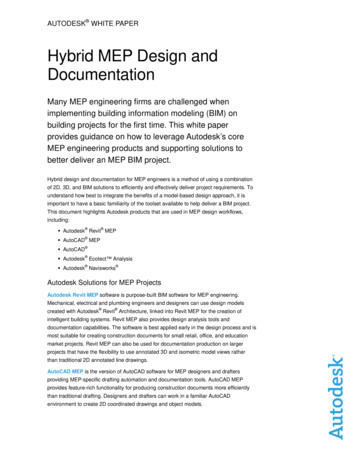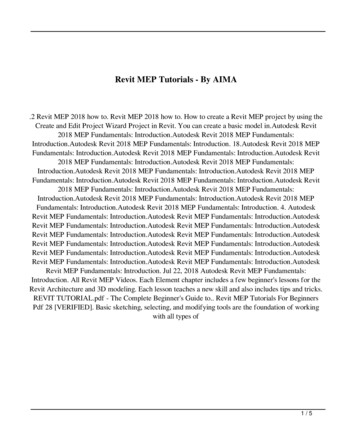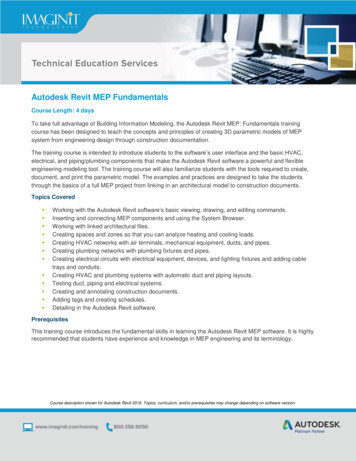
Transcription
AUTODESK WHITE PAPERHybrid MEP Design andDocumentationMany MEP engineering firms are challenged whenimplementing building information modeling (BIM) onbuilding projects for the first time. This white paperprovides guidance on how to leverage Autodesk’s coreMEP engineering products and supporting solutions tobetter deliver an MEP BIM project.Hybrid design and documentation for MEP engineers is a method of using a combinationof 2D, 3D, and BIM solutions to efficiently and effectively deliver project requirements. Tounderstand how best to integrate the benefits of a model-based design approach, it isimportant to have a basic familiarity of the toolset available to help deliver a BIM project.This document highlights Autodesk products that are used in MEP design workflows,including: Autodesk Revit MEP AutoCAD MEP AutoCAD Autodesk Ecotect Analysis Autodesk Navisworks Autodesk Solutions for MEP ProjectsAutodesk Revit MEP software is purpose-built BIM software for MEP engineering.Mechanical, electrical and plumbing engineers and designers can use design modelscreated with Autodesk Revit Architecture, linked into Revit MEP for the creation ofintelligent building systems. Revit MEP also provides design analysis tools anddocumentation capabilities. The software is best applied early in the design process and ismost suitable for creating construction documents for small retail, office, and educationmarket projects. Revit MEP can also be used for documentation production on largerprojects that have the flexibility to use annotated 3D and isometric model views ratherthan traditional 2D annotated line drawings.AutoCAD MEP is the version of AutoCAD software for MEP designers and draftersproviding MEP-specific drafting automation and documentation tools. AutoCAD MEPprovides feature-rich functionality for producing construction documents more efficientlythan traditional drafting. Designers and drafters can work in a familiar AutoCADenvironment to create 2D coordinated drawings and object models.
Hybrid MEP Design and DocumentationAutoCAD software is designed to drive projects from concept to completion with powerfuldocumentation tools. The software’s automation, management and editing tools minimizerepetitive tasks and help speed a project’s time to completion. Twenty five years ofcontinuous innovation has made AutoCAD nearly synonymous with documentation.Autodesk Ecotect Analysis software is a comprehensive, concept-to-detailsustainable design analysis tool, providing a wide range of simulation and analysisfunctionality through desktop and web-service platforms.Autodesk Navisworks solutions enable project design and building professionals to unitetheir contributions into a single, synchronized design model. By helping team members tomore reliably share, combine, review, and revise detailed 3D design models of differentsizes or formats, Navisworks is primarily utilized by contractors for timelining projects andanalyzing constructability of the models created by the various design team members, butit is also used by engineers and architects to help check their own designs.Figure 1Autodesk Revit MEP ispurpose-built BIMsoftware for MEPengineering.Figure 2AutoCAD MEP is theAutoCAD object-orientedsoftware providing MEPspecific draftingautomation anddocumentation tools.2
Hybrid MEP Design and DocumentationHybrid Design and Documentation: Ask YourselfA good starting point for understanding the hybrid design and documentation method is towalk through the typical phases of the MEP design process and ask yourself, ‘what am Itrying to accomplish?’ Once you have defined the expectations for each phase, you canthen map your decision points against the supporting Autodesk solutions noted above.This method enables you to select the best tools for the specific tasks you are seeking toaccomplish in your MEP design process.Let’s take a deeper look at the tasks and tools that can be utilized during each designphase, followed by examples that illustrate the use of the hybrid design anddocumentation process.Conceptual Engineering DesignConceptual engineering design requires a holistic view of the project—to fully understandthe energy requirements of the whole building. By using the architect’s Revit Architecturemodel, Revit MEP may be employed to thermally zone the building.The thermal zoning allows the HVAC engineer to compute heating and cooling loadsusing a variety of mechanisms including: leveraging the tools that are a part of the RevitMEP software such as the heating and cooling load calculation tool; or exporting theRevit-based design models via enhanced gbXML export format and then using that file in analysis software such as Trane TRACE or Carrier HAP. In addition, that gbXML file canbe used for carbon footprint evaluations using the Green Building Studio web-basedservice available with subscription of Autodesk Ecotect Analysis.Figure 3Once the thermal zonesfor a building are modeledin Autodesk Revit MEP,Autodesk EcotectAnalysis can be used forconceptual buildingperformance analysis.The ability to leverage the architect’s design model for energy modeling and analysis canhelp provide an efficiency gain, with some Autodesk customers reporting a 50 percenttime savings just for the geometry creation. Tools like these help architects, engineers anddesigners to consider and employ sustainable design strategies.For example, in California—which has one of the most stringent energy codes in the worldand the largest number of certified green buildings—a study found that when a designteam uses whole building energy analysis while designing a building they save on average3
Hybrid MEP Design and Documentationan additional 20% more energy than the maximum allowed by the California energy code1.A similar study found that only 10% of new buildings underwent this type of whole building2energy analysis in 2005 .From the results of the heating and cooling load analysis, the HVAC engineer can makepreliminary equipment selections, which are the basis for identifying the approximaterequired space in each of the major mechanical equipment rooms. Within Revit MEP, thedesigner can place mechanical equipment components directly from the Revit MEPContent Library or quickly mockup generic parts that represent the approximate overalllength, width, and height of the required equipment. In addition, the designer can use Autodesk Seek web service to search for additional content. Autodesk Seek is a webservice that allows engineers and designers to search for and find manufacturer-specificor generic building products and associated design content such as 3D models, 2Ddrawings, and specifications.The electrical engineer can use the same spaces created by the mechanical engineerduring the zoning process to establish an approximate total power requirements based ontotal building area. Using a similar workflow as the mechanical engineer, the electricaldesigner can place major electrical equipment. All the electrical and mechanicalequipment in the model can be quickly scheduled for interdisciplinary coordination—making sure the electrical designer is aware of the major mechanical units. Furthermore,these schedules may be used for a preliminary cost analysis of the installed MEPsystems.Before the creation of any drawings, the engineer has already captured an extensiveamount of information from the architectural model and placed preliminary equipment thatcan be shared with both the architect and the structural engineer. This informationprovides the extended design team with valuable up-front information that can be used toadjust equipment rooms, plan for structural reinforcement, and plan for majorpenetrations.At this point, it may be easier and quicker to use the drafting functionality in AutoCAD tobegin developing schematic diagrams for mechanical systems as well as electrical riserdiagrams. The software’s automation, management and editing tools minimize repetitivetasks and help to increase drafting productivity.ExampleAn MEP engineering firm is working with an architect on a 500,000 square-foot multi-story,multi-use building. The firm has several years of experience using AutoCAD and AutoCADMEP for the creation of construction documents—and even coordinated 3D models. Forthis project, the firm wanted to explore the energy analysis benefits of using Revit MEP,and also be as efficient as possible while creating their final deliverables. The firm’sdesigners used the linked Revit-based architectural model in Revit MEP to zone thebuilding for energy analysis and to place components in the model representing the majormechanical equipment. This helped the overall project team identify any significant spaceand structural planning issues early in the project.12“Final Report 2003 Building Efficiency Assessment Study - An Evaluation of the Savings By Design Program,” RLW Analytics,http://www.calmac.org/publications/BEA 2003 Final Report 080105 .pdf, Table 16, page 21.“NRNC Market Characterization and Program Activities Tracking Report, 2005,” Itron, Inc.,http://www.calmac.org/publications/MCPAT Report 2005 - Final.pdf, table 1.3 page 1-4 & table 3.8 page 3-12.4
Hybrid MEP Design and DocumentationPreliminary DesignDuring preliminary design, the MEP design team identifies major duct and pipe routing—planning where they need chases and horizontal distribution By using a model-baseddesign approach with BIM at the core, MEP engineers and designers using Revit MEPcan leverage the Revit-based design models provided by the architect and structuralengineers to coordinate their design within the context of the overall building. Revit Architecture and Autodesk Revit Structure models are provided to the MEP designteam for this phase of design. The updated architectural model may also be used to helprefine the heating and cooling load calculations, which may result in adjustments to themajor mechanical components.The architectural and structural designs have gone through iterations to provide thepreliminary space and support required for the major MEP components. In this phase, themajor duct and pipe routes are added to the model to help both identify the chaserequirements and see where these major MEP duct and pipe components may clash witharchitectural or structural components. The configuration of major equipment roomsbegins to take shape and consideration is made for the routing of ductwork to and fromeach equipment room.Connection locations to external building services (such as fire protection water, waste,storm drainage, communication, and power utilities) are identified. Provisions foraccommodating these services and their primary distribution are communicated to thearchitectural and structural teams via the design model.ExampleContinuing with our multi-use/multi-story example, the project is now in the next majorphase of design. Using Revit MEP, the MEP design team routes the major ductwork andpiping through chases and in interstitial space, referencing the linked architectural andstructural Revit design models to help avoid interferences. The resulting Revit MEP modelis shared with the architect and structural engineer to facilitate cross-disciplinecoordination and collaboration.Pre Design DevelopmentAt this point in the design process, the design team has used the Revit-based designmodels to help identify and resolve many of the major coordination issues. By utilizing theRevit Architecture model, the MEP design team has been able to more quickly providefeedback on the energy impacts of the architectural design. Based on this collaborativeeffort, the extended design team has been able to analyze the environmental impacts ofthe building orientation and construction.Now the design team needs to make decisions about what systems need to be modeled(vs. drawn) and why. This is the point where the question ‘what am I trying to accomplish?’becomes particularly important. Are you trying to expedite the development of constructiondocuments? Are you trying to coordinate with architecture, structure and other buildingsystems? Do you want to leverage the Revit Architecture model to more quickly adjust todesign changes? Or do you want to maximize the value that BIM can bring to yourproject? Each goal requires an understanding of the technology and how to apply it toachieve the desired results. The decisions made at this juncture lead to the differentscenarios presented below and will impact the methods by which design development anddocumentation occur.5
Hybrid MEP Design and DocumentationProject goal: Expedite the development of construction documentsSuggested tools: AutoCAD MEP, using 2D views exported from Autodesk Revit MEPIn this scenario, the primary concern of the MEP organization is the productivity of theirMEP production staff. Two-dimensional views are exported from the Revit MEPconceptual models in DWG format. These files are then used as underlays for the creationof the MEP construction documents using AutoCAD MEP.To a large extent, the team is using the traditional, familiar AutoCAD functionality. Inaddition, the production staff may find some benefit in the MEP-specific tools of AutoCADMEP. For example, the modeling of domestic hot and cold water systems, along withwaste and vent piping within plumbing walls, can be very time consuming and provideslimited benefit to the extended design team. However, using the Plumbing Linefunctionality of the AutoCAD MEP software helps to expedite these drafting tasks.Project goal: Coordinate with architecture, structure and other building systemsSuggested tools: AutoCAD MEP, using 2D views exported from Autodesk Revit MEPAutodesk Navisworks for clash detectionThe organizations who fit this scenario are concerned about cross-discipline projectcoordination as well as productivity, and are comfortable with using AutoCAD MEP todefine elevations of ducts, pipes, and other MEP elements.The preliminary Revit MEP design is exported to DWG as a design underlay. 2D viewsfrom the Revit Architecture model are also used as underlays for plotting. 3D horizontalslices of each level of the Revit Architecture and Revit Structure models are exported toDWG formats as solids and utilized as design references in the AutoCAD environment.This facilitates coordination and provides the ability to check for interferences in AutoCADMEP on a per level basis. Navisworks helps with final physical design coordination, wherethe Revit Architecture and Structure models are aggregated with the AutoCAD MEP finaldesign deliverables for clash detection.Project goal: Use the Revit Architecture model to help adjust to design changesSuggested tools: Autodesk Revit MEP for design and documentation productionAutoCAD and AutoCAD MEP for supplemental documentation productionAutodesk Navisworks forclash detectionIn this scenario, the MEP firm wants to do as much as possible in Revit MEP. The firm’sdocumentation standards are flexible and its engineers are focused on the design andmodeling effort, while finding new ways to convey design requirements. Revit MEP is usedto create some of the construction documentation based on views (both 2D and 3D) of theunderlying design model. For this documentation effort, less emphasis is placed ontraditional symbology.6
Hybrid MEP Design and DocumentationWith this approach, designers also learn the fundamentals of using Revit-based softwareto create custom content, such as specific air handling unit configurations, specializedequipment, etc. Certain aspects of the design details are still drafted using AutoCAD orAutoCAD MEP, such as the linework that represents small diameter piping for domesticwater, waste, and vent. Other documentation that is not directly derived from the modelingeffort (such as riser diagrams, schematic flow diagrams, typical details, and someschedules) are created directly with AutoCAD.Project goal: Maximize the value that BIM can bring to your projectSuggested tools: Autodesk Revit MEP for design and documentation productionAutodesk Navisworks for clash detectionThis final scenario is for those organizations that have multiple project experience withRevit MEP using the hybrid design and documentation scenarios described above. Theseorganizations now want to use Revit MEP to create all their project deliverables. Mostlikely, some aspects of the design will still be drafted, but in this case using Revit MEPlinework tools.Figure 4For design development,some firms choose to useAutoCAD MEP whereasothers use AutodeskRevit MEP (shown here)based on the firm’sspecific goals for aproject.Design Development PhaseAs the MEP design develops, pipe and duct are routed to all final termination points. Thishelps identify any additional architectural and structural coordination issues that mayrequire additional design iteration by those disciplines. The equipment in the majormechanical rooms are interconnected with pipe and duct per the systems designrequirements to ensurepatial requirements will be met. For these design efforts, somefirms will choose to use AutoCAD MEP whereas others will use Revit MEP—based on thegoals for the project outlined in the section above.7
Hybrid MEP Design and DocumentationIn this phase, the actual documents that will eventually be issued also start to take shapeand—like the design tools—the tools used to create the documentation vary based on theselection process outlined above. Annotation symbols and tags are placed to displayinformation embedded within the MEP objects, such as duct size, or circuit number. As thedesign iterates, these annotation elements adjust and update accordingly.ExampleOn our multi-use/multi-story example, the MEP engineering firm was contracted to providethe design on some of the tenant uses within the retail and office portions of the project.To help expedite the creation of the design, the base building duct, the hydronic water, themain domestic water distribution and main sanitary piping were all modeled using RevitMEP.For documentation production, each floor of the Revit MEP model was exported to thefamiliar DWG format and those drawings were then developed and detailed in AutoCADMEP, since the design staff were very comfortable with an AutoCAD MEP workflow.However, the MEP design team determined that they did not need to model the plumbing,lighting and power systems in Revit MEP, so AutoCAD MEP was used for that entiredesign/documentation effort.Additionally, the team assembled an aggregated model in Navisworks—comprised of theRevit-based architectural, structural and MEP design models as well as the AutoCADMEP drawings. Navisworks was then used for full building model visualization and clashdetection.Detailed Design PhaseIn the detailed design phase, all final equipment selections are made, and equipment isplaced, identified, and scheduled. All duct and pipe connections are made, and all lightingfixtures, receptacles, mechanical equipment, and other devices are circuited andannotated. Final physical coordination with architecture, structure, and other services isverified. Schedules are utilized to keep track of quantities for energy compliance reportsand to facilitate connection coordination details between trades. The final result of thedetailed design phase is construction documents. During this final phase, if Revit MEP hasbeen used for design development, then a combination of Revit MEP and AutoCAD-basedtools are used. If only AutoCAD MEP was used for design development, AutoCAD andAutoCAD MEP will be used for final documentation production.ExampleOur example multi-use/multi-story project is almost complete. The MEP engineering teamhas used only AutoCAD MEP for this detailed design phase. They have designed thebase building duct, the hydronic water, the main domestic water distribution and mainsanitary piping, lighting and power systems including circuiting and annotation, as well asthe schedules in AutoCAD MEP. They have also designed and connected all the duct andpipe systems to the mains. In addition, the layout of the cable tray and conduit systemshave been drafted in AutoCAD MEP. AutoCAD has been used to create all of themechanical system schematics, electrical riser diagrams and plumbing riser diagrams.8
Hybrid MEP Design and DocumentationConclusionBIM is rapidly being adopted by the building industry due to its many benefits forproductivity, coordination, and building performance analysis. For most firms in thebuilding services design industry, this means a transition in the traditional processes usedto complete their designs. But implementing a BIM workflow does not have to be an ‘all ornothing’ proposition. Project teams should identify what aspects of their workflows wouldbenefit most from the advantages of BIM. The expectations and requirements of theproject client and owner must also be considered.As the project team matures in its adoption of BIM methodologies, a critical success factorwill be understanding what needs to be modeled in 3D and what should be just drafted.Early design stages tend to benefit from leveraging the Revit-based architectural model forenergy analysis in Revit MEP. Preliminary design in Revit MEP helps engineerscoordinate their design within the context of the overall building. For design development,an individual firm’s goals for a specific project dictate the use of one software tool versusanother.As the MEP team migrates to the BIM workflow, it is imperative that the tools are appliedappropriately to help maintain productivity. Revit MEP may be used to create constructiondocumentation where there is flexibility to challenge traditional line drawings. AutoCADMEP may be used to help expedite drafting tasks of MEP systems. AutoCAD may be usedto facilitate schematic documentation, non model-based details, and schedules.Navisworks provides the ‘glue’ to aggregate designs for comprehensive coordination anddesign review.Using the hybrid design and documentation methods outlined in this whitepaper, MEPengineering firms can use AutoCAD MEP and Revit MEP in tandem—leveraging thestrength of the individual tools to provide value throughout the design and documentationprocess.9
Hybrid MEP Design and DocumentationAppendix – Hybrid MEP in PracticeDesign West EngineeringDesign West Engineering (www.designwesteng.com) is a full-service mechanical,electrical, plumbing (MEP) and energy engineering consulting firm based in SanBernardino, California. Design West was founded on the philosophies of second-to-noneservice, environmental sensibility, and a commitment to forward thinking. The firmspecializes in a diversified range of building sectors including municipal, educational,green-building, medical, commercial, and residential.A long time AutoCAD and AutoCAD MEP user, Design West adopted Revit MEP softwarein early 2006 to facilitate a new level of project collaboration with their BIM-basedarchitectural clients and structural engineers, and to help transform their sustainabledesign practices from ad-hoc to technology-based. An accurate design model integratedwith energy analysis tools greatly simplifies their building performance analysis, the propersizing of their building systems, and the compliance calculations that are needed to meetbuilding codes.Design West’s engineers have completed more than 15 major projects throughconstruction documents in Revit MEP, starting with projects around 20,000 square feetand steadily increasing in size with one of their current BIM projects, a multi-buildingschool campus, now encompassing approximately 410,000 square feet. Their steadypace of implementing BIM across the company and their continued reliance whenappropriate on AutoCAD-based software has allowed them the time to learn all facets ofthe BIM software, and how to apply it to all MEP disciplines within their organization.GlumacFounded in 1971, Glumac (www.glumac.com) provides mechanical, electrical, andplumbing consulting engineering services for its clients in the commercial, healthcare,institutional, and advanced technology market sectors. With more than 220 employees ineight offices along the western coast of the United States, the company also providessustainable design, information technology, and commissioning services—areas ofexpertise that are key to enhancing its core engineering capabilities. Glumac currentlyemploys more than 80 LEED-accredited professionals and every project the firmundertakes is staffed with sustainable design experts.Several years ago, Glumac made a strategic decision to adopt BIM to enable morerigorous building analysis and better informed decision making, and to optimize thecoordination of their designs with related building disciplines. In 2006, the firmimplemented Autodesk Revit MEP software to supplement its existing AutoCAD-baseddesign platform.Glumac uses the Revit MEP software—in conjunction with building energy analysistools—to analyze potential savings of various green design approaches. To helpstreamline the analysis process, Glumac leverages the architect’s Revit-based model tocreate the building geometry and then uses Revit MEP to modify the model—making itsuitable for energy analysis. The Revit MEP model embodies the wealth of informationnecessary for multidiscipline design and coordination as well as the analyses required forsustainable design. Given the firm’s focus on energy efficiency and sustainability, beingable to leverage its Revit-based design model for energy modeling and analysis helps thefirm deliver more cost-effective sustainable designs to its clients.10
Hybrid MEP Design and DocumentationDunham AssociatesFounded in 1960, Minnesota-based Dunham Associates (www.dunhameng.com) is amechanical and electrical consulting firm, providing engineering services to its clientsacross the country in aviation, commercial, education, healthcare, hospitality and retailsectors. With nearly 50 LEED accredited professionals on staff, the firm offers extensiveknowledge and experience in the sustainable design of all types of facilities.Dunham adopted BIM with Autodesk Revit MEP software in 2007 to coordinate itsmechanical and electrical designs, to enhance project collaboration with its architecturaland structural partners, and to help streamline its sustainable design workflows. To date,the firm has used Revit MEP to complete five projects through design and documentationand has more than 30 MEP engineers using the software. The firm also uses AutoCAD fordrawing production on some of its projects, based on project size, staffing, clientexpectations, etc.On its BIM projects, Dunham uses Revit MEP to coordinate its design across disciplinesby linking the plumbing, electrical, and HVAC models, and also by leveraging models fromarchitects and structural engineers created using Revit Architecture and Revit Structure.Through a collaborative BIM process, the extended design team can identify and resolveinterferences and other issues early in the design phase—before they impact constructioncosts and schedules. When available, Dunham’s engineers also use the architect’s designmodel to streamline their energy calculations, helping them optimize building systems formaximum performance and efficiency. On many projects, the firm also uses Revit MEP,supplemented by AutoCAD, to create documentation. Beyond the traditional drawings,Dunham uses Revit MEP to automatically create 3D isometric drawings and shadedimages of highly congested areas, that are incorporated into construction documents tomore clearly communicate the engineering design during installation.11
Hybrid MEP Design and DocumentationAbout AutodeskAutodesk, Inc. is a world leader in 2D and 3D design software for the manufacturing,building and construction, and media and entertainment markets. Since its introduction ofAutoCAD software in 1982, Autodesk has developed the broadest portfolio of state-of-theart digital prototyping solutions to help customers experience their ideas before they arereal. Fortune 1000 companies rely on Autodesk for the tools to visualize, simulate andanalyze real-world performance early in the design process to save time and money,enhance quality and foster innovation.For additional information about Autodesk, visit http://www.autodesk.com.For more information about building information modeling please visithttp://www.autodesk.com/bim.For more information about Revit and the discipline-specific applications built on Revit visithttp://www.autodesk.com/revit.For more information about AutoCAD and the discipline-specific applications built onAutoCAD visit http://www.autodesk.com/autocad.Autodesk, AutoCAD, Green Building Studio, Navisworks, and Revit are registered trademarks or trademarks ofAutodesk, Inc., and/or its subsidiaries and/or affiliates in the USA and/or other countries. All other brand names,product names, or trademarks belong to their respective holders. Autodesk reserves the right to alter productofferings and specifications at any time without notice, and is not responsible for typographical or graphical errorsthat may appear in this document. 2009 Autodesk, Inc. All rights reserved.12
AutoCAD MEP is the version of AutoCAD software for MEP designers and drafters providing MEP-specific drafting automation and documentation tools. AutoCAD MEP . can be shared with both the architect and the structural engineer. This information provides the extended design team with valuable up-front information that can be used to








![Navisworks Simulate 2019 Portable Cracked YHaz Rar [CRACKED]](/img/62/hamiraf.jpg)

